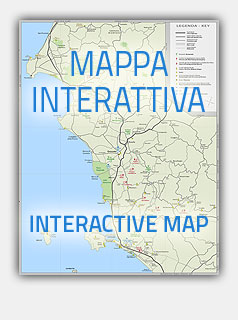
The park is dominated by two major vegetation zones: the Mediterranean wood sclerophyllus, better known as “maquis” and precisely cerreta dominated by oak (Quercus cerris) ..
With an acceptable approximation, we can say that as regards the mammals are certainly present: Roe (Capreolus capreolus), Fallow Deer (Dama dama) and wild boar (Sus scrofa), the latter particularly abundant; the Fox (Vulpes vulpes) and porcupine (Hystrix cristata) are common and are also present the Badger (Meles meles), the Stone Marten (Martes foina), the weasel (Mustela nivalis), hedgehogs (Erinaceus europaeus), Hare (Lepus europaeus) and the squirrel (Sciurus vulgaris), while they are likely attendance of Wildcat (Felis silvestris), marten (Martes martes) and polecat (Mustela putorius). Recently the return of the wolf (Canis lupus) was ascertained. Among the mammals is certainly present the dormouse (hazel dormouse), while other important species, such as Dormouse (Myoxus glis), Mouse dormouse (Elyomis quercinus) and shrew (Etruscan shrew, the smallest mammal in Europe), are not confirmed. Particularly rich in the presence of bats for the abundance of cavities, large old-growth trees and ruins. Waiting for field research, the only species of bat is confirmed the Greater Horseshoe Bat (greater horseshoe bat), observed and photographed in a gallery for the extraction of alum. Recently, it has been photographed in the same site is also a rare example of the Horseshoe
With an acceptable approximation, we can say that as regards the mammals are certainly present: Roe (Capreolus capreolus), Fallow Deer (Dama dama) and wild boar (Sus scrofa), the latter particularly abundant; the Fox (Vulpes vulpes) and porcupine (Hystrix cristata) are common and are also present the Badger (Meles meles), the Stone Marten (Martes foina), the weasel (Mustela nivalis), hedgehogs (Erinaceus europaeus), Hare (Lepus europaeus) and the squirrel (Sciurus vulgaris), while they are likely attendance of Wildcat (Felis silvestris), marten (Martes martes) and polecat (Mustela putorius). Recently the return of the wolf (Canis lupus) was ascertained. Among the mammals is certainly present the dormouse (hazel dormouse), while other important species, such as Dormouse (Myoxus glis), Mouse dormouse (Elyomis quercinus) and shrew (Etruscan shrew, the smallest mammal in Europe), are not confirmed. Particularly rich in the presence of bats for the abundance of cavities, large old-growth trees and ruins. Waiting for field research, the only species of bat is confirmed the Greater Horseshoe Bat (greater horseshoe bat), observed and photographed in a gallery for the extraction of alum. Recently, it has been photographed in the same site is also a rare example of the Horseshoe

Alum cave of Montioni
Alum quarries are located within the interprovincial Park of Montioni, managed by the provinces of Livorno and Grosseto. Alum was discovered at Montioni in 1474 and remained inactive for a long time, the quarries were reopened in 1803, but only during the reign of Elisa Baciocchi, became Princess of Piombino in 1805, began their production.
Elisa indemaniare did the cave, they rent to Jean Gabriel Eynard, his financial advisor, and in 1808 the cave Gallery eight, two and six were reactivated under the open sky. The French businessman Louis Gates received by Elisa appointed Managing of allumiera di Montioni and in 1811 was appointed Director to the dependencies of the principles. In the time of Louis alum ore extraction Ports took place, in the area of Montioni, both in mine in the quarry. The alum rock was subjected to a first choice and transported to the kiln for calcination; calcined ore was being done then soak and dissolve in water, cooked again in copper kettles and crystallized, ready to be transported in Commerce. At this point alum was shipped to the port of Follonica employing the camel as a mode of transportation.
At the time of the fall of the Napoleonic regime the principles decided to close the allumiera, doors was removed from Office and the mine was leased to Swiss Etienne Richard.
Free and open access






 Home
Home Home
Home